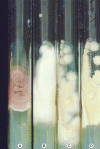Decreasing incidence of Trichophyton mentagrophytes in Korea: analysis of 6,250 cases during the last 21-year-period (1992-2012)
- PMID: 24550657
- PMCID: PMC3924009
- DOI: 10.3346/jkms.2014.29.2.272
Decreasing incidence of Trichophyton mentagrophytes in Korea: analysis of 6,250 cases during the last 21-year-period (1992-2012)
Abstract
Trichophyton mentagrophytes is the second common dermatophyte in Korea. However, few reports have been issued on the epidemiological and mycological characteristics of T. mentagrophytes in Korea based on long-term, large-scale study. The purpose of this study was to elucidate the epidemiological and mycological characteristics of T. mentagrophytes in Korea. During the 21-yr-period from 1992 to 2012, 6,250 patients with T. mentagrophytes were surveyed to determine annual incidence and the distribution of subjects by age, sex, season, involved sites, and place of residence. T. mentagrophytes infections were confirmed by fungal culture. In addition, the colony appearance of T. mentagrophytes was classified as granular, persicolor, powdery, or downy. Epidemiological analysis showed that annual incidence reached a peak in 2005, and then gradually decreased. T. mentagrophytes infection was most common in July, and was found predominantly in middle-aged adults, especially in those in their forties. Mycological analysis showed a powdery colony appearance was the most common, followed by persicolor and granular colonies. Toewebs were most frequently involved. This investigation on T. mentagrophytes provides insights into its incidence and characteristics.
Keywords: Epidemiology; Mycology; Trichophyton.
Conflict of interest statement
The authors have no conflict of interest to declare.
Figures







References
-
- Kim BS, Suh SB. Mycological and clinical observations on dermatophytosis. Korean J Dermatol. 1976;14:325–334.
-
- Moon HJ, Lee JB, Kim SJ, Lee SC, Won YH. Clinical and mycological studies on dermatomycosis (1991-2000) Korean J Med Mycol. 2002;7:78–85.
-
- Kim KH. Dermatophytes isolated from Korea. Yeungnam Univ J Med. 1990;7:13–26.
-
- Rippon JW. Medical Mycology: the pathogenic fungi and the pathogenic actinomycetes. 3rd ed. Philadelphia: WB Saunders; 1988. pp. 121–275.
-
- Emmons CW. Dermatophytes: natural groupings based on the form of the spores and accessory organs. Arch Derm Syphilol. 1934;30:337–362.
MeSH terms
LinkOut - more resources
Full Text Sources
Other Literature Sources
Medical

